
Gold decoration [SIGNED 833] given as a Gift to Ze'ev Jabotinsky on the occasion of the fiftieth anniversary of his birth by the group of Beitar in Warsaw - Barak' - 'Brith hakanahim' [Alliance of the Fanatics], 1931.
A decoration made of four gold plates on two pieces of fabric in different shades of green and blue. On the front of the golden plates are the inscriptions: "kanahim", "Zelotia", "Warsaw" and a plaque with the emblem of the movement. In their backs are the inscriptions: "To the The fiftieth anniversary of Mr. Z. Jabotinsky our Excellency", The four pieces of gold are signed 833. The head of the decoration is a tiny chain for hanging. The Alliance of the fanatic was founded in the early 1930s, on the basis of the principles of the Betar movement and in fact constituted the most militant Betar movement. At the 17th Zionist Congress held in Basel in July 1931, the Revisionists demanded that Congress explicitly formulate the "ultimate goal" of Zionism: the establishment of a Jewish state in Palestine. But the Labor faction proposed not to put Jabotinsky's vote at all, and she won a majority of 121 to 57. In response, Jabotinsky rose from his chair and called, "This is not a Zionist Congress!" In a protesting act, He tore up his pivot card And left the hall, followed by all his party delegates. In 1931-1932 Jabotinsky led the Revisionist Zionists The Revisionists formed the line by which the faction must take its own initiative, declaring that the ultimate objective of Zionism was the establishment of a Hebrew state, and the sub-group, the Baraq, the Alliance of the Zealots, was established. The sole and declared purpose was to establish a generation of young fighters for the building of the Jewish state, which set a supreme goal for the building of the homeland over the needs of the individual. The movement aims to create ' a solid core of exemplary Hebrew youth. Enthusiastic and daring. gives his soul to the people and freedom. Meat from the flesh and spirit of the ancient zealots " (from the principles of movement). The main points of the movement's plan were: the creation of a Hebrew state on both banks of the Jordan River, and the largest of the Hebrew youth in a pioneering nationalist spirit on the foundations of the tripartite revival of the people, the land, and the Hebrew language. The song of the thugs, which became the anthem of the movement, was sung in all its congregations. To redeem our ancient land ... in blood and fire Judah fell and blood and fire Judah will rise '].
The movement was divided into different age groups - Grade A for ages 12-14, Grade B for ages 14-16, and the highest age group for ages 16-18. The company was divided into three levels of education: scouts, pioneers, defenders, each headed by the head of the company. The outfit was a Ramon-colored shirt with a blue tie, a turban with a black band and lamp. After its expansion, the movement held branches in several countries including Austria, Belgium, Brazil, Eastern Galicia, Poland, Lithuania, France, Romania and Palestine. They published a monthly in Hebrew and Yiddish in the Warsaw press, held world conferences under the leadership of the movement's "High Command" and conducted extensive daily cultural activities, including lectures, Hebrew language and Hebrew history, national cultural events, and more. During the Holocaust, its activities ceased due to Nazi persecution and the few who survived immigrated to Eretz Israel and established the Barkan kibbutz in Beer Yaakov. For more information about the movement, see enclosed material.
The golden decoration before us was given to Jabotinsky in the cradle of the movement's earliest nests, when it numbered only a few dozen members, hence its importance, apart from being a major historical item.
Size: 2x10 cm. Rare item, in very fine condition.
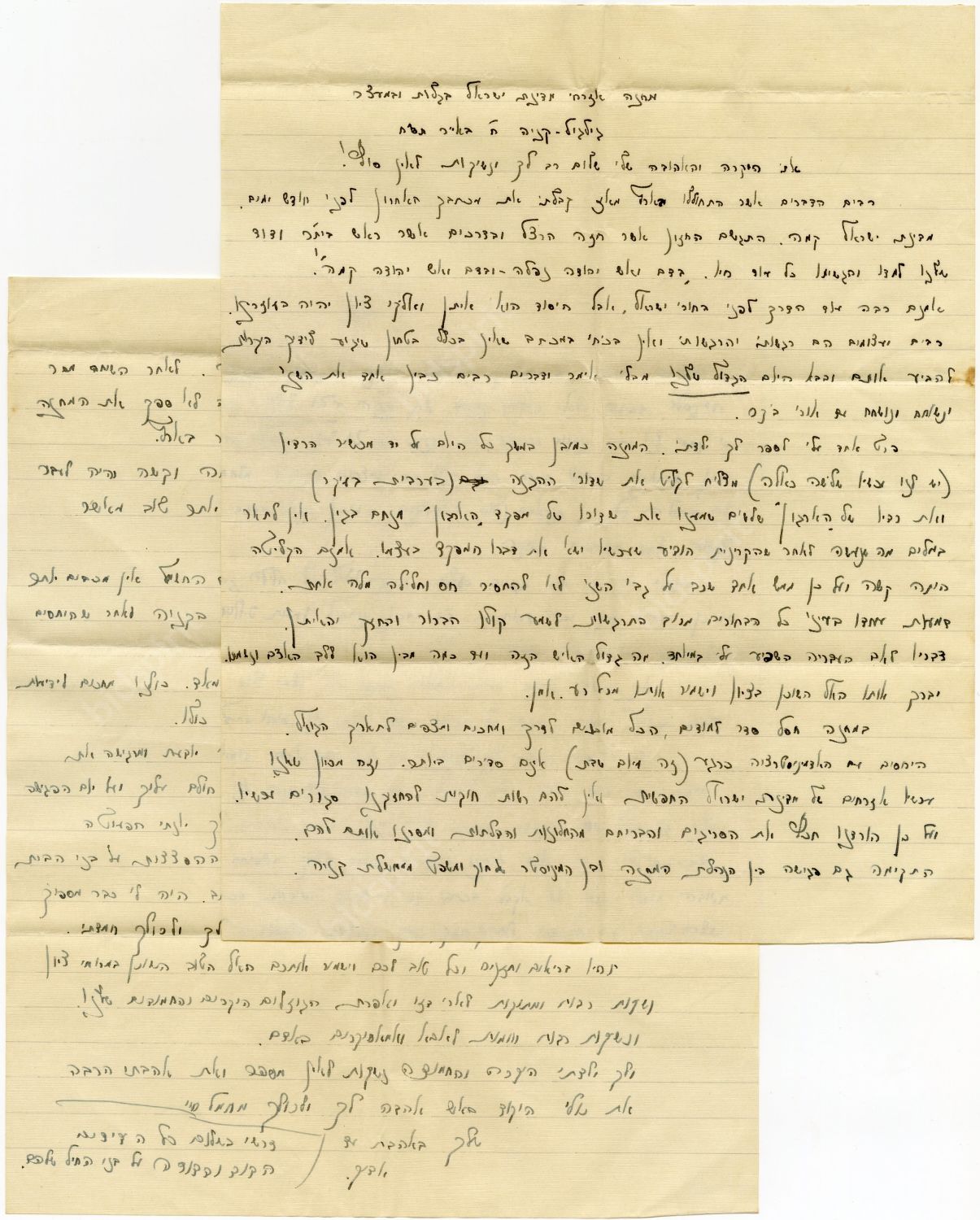
A historical letter in Yehuda Naor's handwriting to his wife, the Etzel member, and later Knesset member Esther Raziel-Naor, who was detained at the Gilgil camp with the announcement of the establishment of the State of Israel, 1948. In the title of the historical letter, Naor chose to write: "The Citizens' Camp of the State of Israel in Exile and Detention Gilgil-Kenya, 8 Iyar 1948". '... The State of Israel was established. The vision that Herzl envisioned and in the ways that our Betar and David leaders realized (meaning David Raziel, commander of the Irgun, the brother-in-law of the writer who was killed in Iraq on a British military mission), Learned and fulfilled them as long as they lived 'in blood and fire Judah fell - and in blood and fire Judah arose' ... My feelings and emotions are enormous and I can not imagine that there is no certainty that you will reach your precious hands to express them ... Throughout the day, next to the radio ... I can hear the broadcasts of the Haganah ... and the organization's radio, Menachem Begin organization. It is impossible to describe what was done after the announcer announced that the commander would now speak for himself. The absorption was difficult, and therefore one person lay on top of the other, not missing one word. Tears stood in the eyes of all the boys in excitement at his clear, strong, strong voice. His words to the mother of the Hebrews influenced me especially, how great is this man and how he understands the heart and soul of man ... ' Yehuda continues to describe the change in the status of the camp residents from disenfranchised detainees to free people who are citizens of an independent state: "In the camp there is no study, everyone is ready to go and wait for the date of the Redeemer. Relations with the administration at the moment are not very regular. And this is because we are now citizens of the free State of Israel, and they have no legal right to keep us closed now. And so we immediately removed the fuses and bolts from the windows and handed them over to them ... '. In addition, Yehuda added as to what was expected in the matter of their arrival in Israel: There was also a meeting between the camp administration and the Minister of Justice and the British government ... After the conversation, the minister stated in writing that at the latest we would leave Kenya on June 15 ... I t is possible that this date is because Egypt declared war and it will be difficult to cross the canal and therefore we will probably fly in the air ... Naor concludes: " We are all waiting for good news from Israel and believing in the strength of the Hebrew youth, which is unlike any other in the world," and concludes with a deep emotional description of his longing for his wife (whom he calls in a letter 'My daughter'): " For almost four and a half years I have been dreaming of you and of the day of our meeting in which we will begin again in the fabric of the dream of our lives ...". Yehuda Naor, husband of Etzel headquarters member and later MK Esther Raziel Naor, was caught by the British police on March 4, 1944, when a radio transmitter was found in her house, and after two months of interrogation Esther Naor was brought to the women's prison in Bethlehem. Her husband, Yehuda, was taken to Aco prison and from there he was deported to the Gilgil camp in Africa where he spent four and a half years until the establishment of the State of Israel.
[2] leaves. In his handwriting. Folding marks. Very fine condition.

* A letter sent from the detention camp in Kenya to the Land of Israel prior to the new year, 21 August 21, 1947. The letter was sent from Yaki to his parents and relatives. after he updated about letters he received, as well as newspaper packages telling about what was happening in the camp: "In the camp, everything goes as before, except that three of the five escapees who escaped from Eritrea at the time were returned. They were caught in the Habash capital and were extradited in violation of any law. In fact, in the country, the law is the money ... and it was difficult for them to compete with the British empire by paying bribes to the various black officials ... I attach a few postcards for a good year. Please send Rosh Hashanah greetings to all our relatives and acquaintances ... ' [1] leaves, 20x 13 cm. fine condition.
* Happy New Year card 'Year of Liberation and Redemption' with an illustration of the map of Africa and the Land of Israel and a landmark of Kenya, the Watchtowers, and the inscription: 'Camp of the Hebrew Expatriates Kenya.' 9x6 cm. Very fine condition.
Attached is the original envelope in which the letter was sent and the "Happy New Year" card.
Beginning in 1944, the Etzel and Lehi exiles were deported to detention camps in Africa in 12 transports. The decision to expel the members of the undergrounds to Africa was accepted by the British in light of the radicalization of the activities of the undergrounds and the recommendation of the Chief Secretary of the Mandatory Government, Acting High Commissioner Sir John Shaw. The British believed that the expulsion to Africa had a strong deterrent element, and would allow the moderate Jewish forces to promote a compromise solution. The detention camps in which they were held were Sambel, near the capital of Eritrea, as well as Carthage in the Sudanese desert and Gilgil in Kenya. A total of 439 persons were deported, and the detention conditions were identical to the conditions in the Latrun camp, where the distance from the families constituted the greatest torture of the detainees, and the detainees suffered from shortages of clothing, toothbrushes, and reading books.
In the Gilgil camp in Kenya where the prisoners were held from March 1947, the conditions were relatively harsh. The former military prison contained dark, stifling cells, infested with mosquitoes and loaded with sewage. A revolt by the prisoners, in which they destroyed the walls to cover the sewers with their stones, finally persuaded the camp commandant to significantly improve the conditions in the camp. With the encouragement of the British, there was extensive educational activity in the camps. A language group was organized under the leadership of Uzi Ornan, and personalities such as Meir Shamgar and Shmuel Tamir acquired legal education through correspondence with British universities and open university examinations. The exiles were returned to Israel a few months after the establishment of the State of Israel.
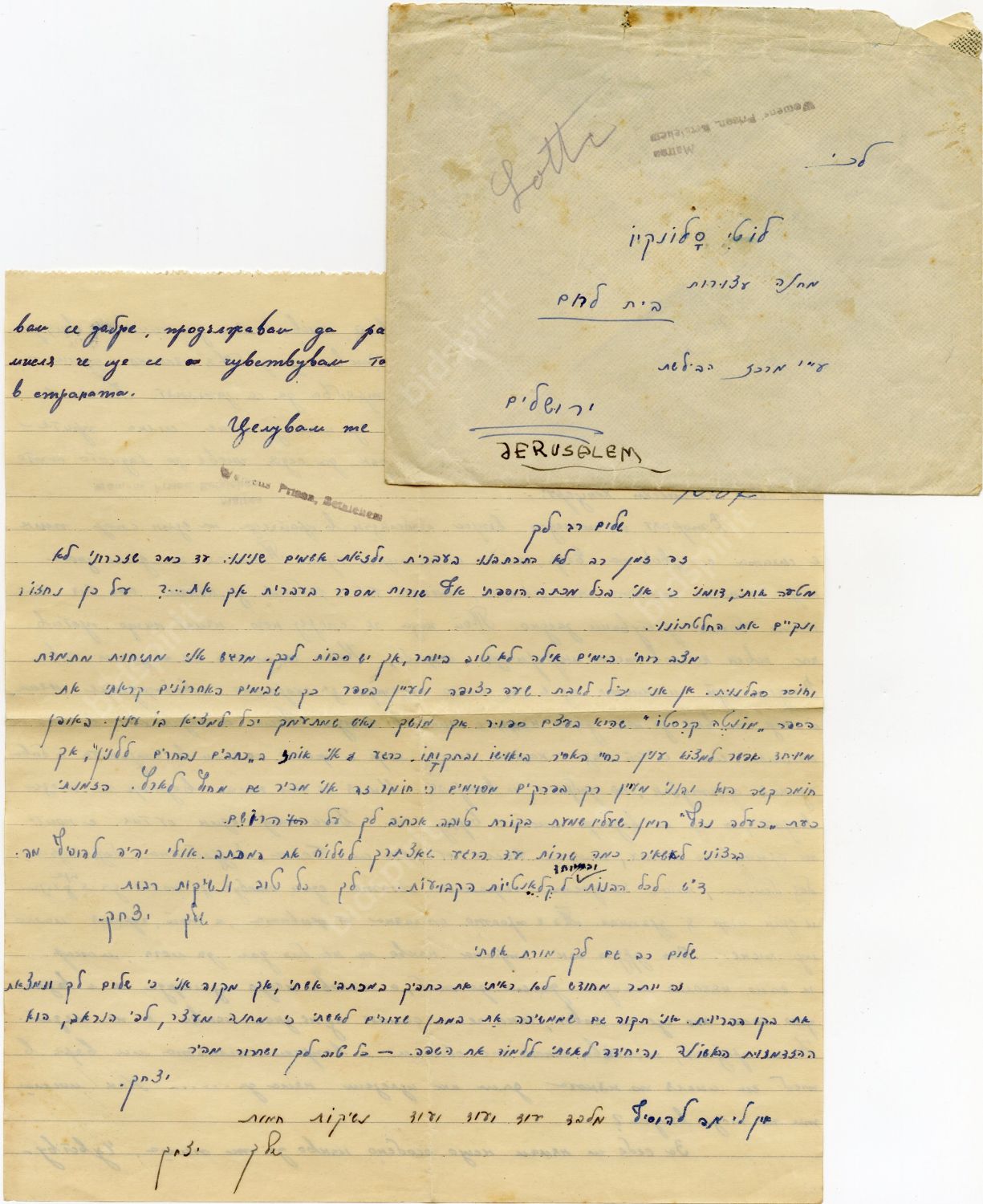
A letter in the handwriting of Etzel member Yitzhak Slunikio, who was arrested in March 1947 and imprisoned in Latrun detention camp to his wife, Loti Slunkyo, during her stay in the Bethlehem detention camp.
The first part of the letter is written in Bulgarian and continues in Hebrew. Salonkyo opens his letter: "We have not corresponded in Hebrew for a long time, and both of us are to blame for this".He tells how the book 'Monte Cristo' makes him interested in the life of the prisoner, in despair and hope. And describes his feelings of imprisonment. On the margins of the letter he added three lines that were intended for his wife's Hebrew teacher: "I am very happy that you continue to give lessons to my wife that the detention camp is apparently the first and only opportunity for my wife to learn the language ..."
Attached is the original envelope in which the letter was sent.
[1] leaf written on both sides: 24x22 cm. folding marks, very fine condition.

" I was particularly thrilled by the story of the Emmanuel harussi ... that the work of my empowerment and redemption has not yet been completed ... and each one of us old and young, will take another great and long effort to fortify our independence ..." - two important letters in his handwriting and signature of David Ben. October 1966.
"To Yaakov Guthertz, Greetings.
The well-known author Emmanuel harussi wrote to me that When you went up to the Torah on Last Yom Kippur, and when you had finished your blessing, you added for me the 'mi sheberach' blessing for my 80th birthday. I have received thousands of greetings from all over Israel and the Diaspora, and I do not say that these blessings were easy for me. I was happy for every blessing and blessing I received - but I was especially impressed by the story of Emmanuel harussi. I send you my deep appreciation and my sincere blessing that you will be pleased with your child and your grandchildren and will succeed in raising them to Torah and good deeds . That the work of my strength and redemption is yet to be completed, and that the work is still long before us, and every one of us, old and young, will need another great effort to fortify our independence and complete the ingathering of the exiles and making Israel worthy of the prophecy prophesied by yeshaiah ben Amotz..." Ben Gurion. Nof Yam neighborhood" . Two unusual letters that reveal unknown layers in Ben-Gurion's personality. The two letters, on the same subject ['continuation' letters] are addressed to the writer and Zionist activist Haganah member - Immanuel harussi [1903-1979]. In one letter, Ben-Gurion comments that he is enclosing other letter he sent to Yaakov Gothertz When he heard the story, he stood up to greet him with the blessing of Mi Shevrech on the occasion of Ben-Gurion's 80th birthday, His ascension to the Torah on the very day of Yom Kippur against a respectable contribution and add he is especially grateful to the Emanuel harussi for his effort to tell him about Gothertz's " His very esteemed deed. " In his second letter, which is actually a copy of the letter he sent to Gutthertz, Ben-Gurion expresses his admiration and gratitude to Yaakov Gothertz for his deed, and adds to his blessing that he will be able to raise his children and grandchildren to Torah and good deeds and adds words of vision that begin with the singular: 'The work of my empowerment and redemption is yet to be completed' In light of yeshaiah ben Amotz's prophecy regarding the fortification of Israel's independence and the completion of the ingathering of the exiles. Ben-Gurion's 80th birthday was a very important event in Israeli public life. Apart from the blessings he received from all over the Israeli spectrum, there were also many who came to visit him and wish him the blessing of Mazal Tov in his home. In particular, the photograph was published in which the chief of staff at the time, Yitzhak Rabin, arrived at his home in Sde Boker to congratulate him on the occasion.
[2] leaves. Both written and signed by Ben-Gurion. Attached is the original envelope in which the letters were sent to Mr. Emanuel harussi. Very fine condition.
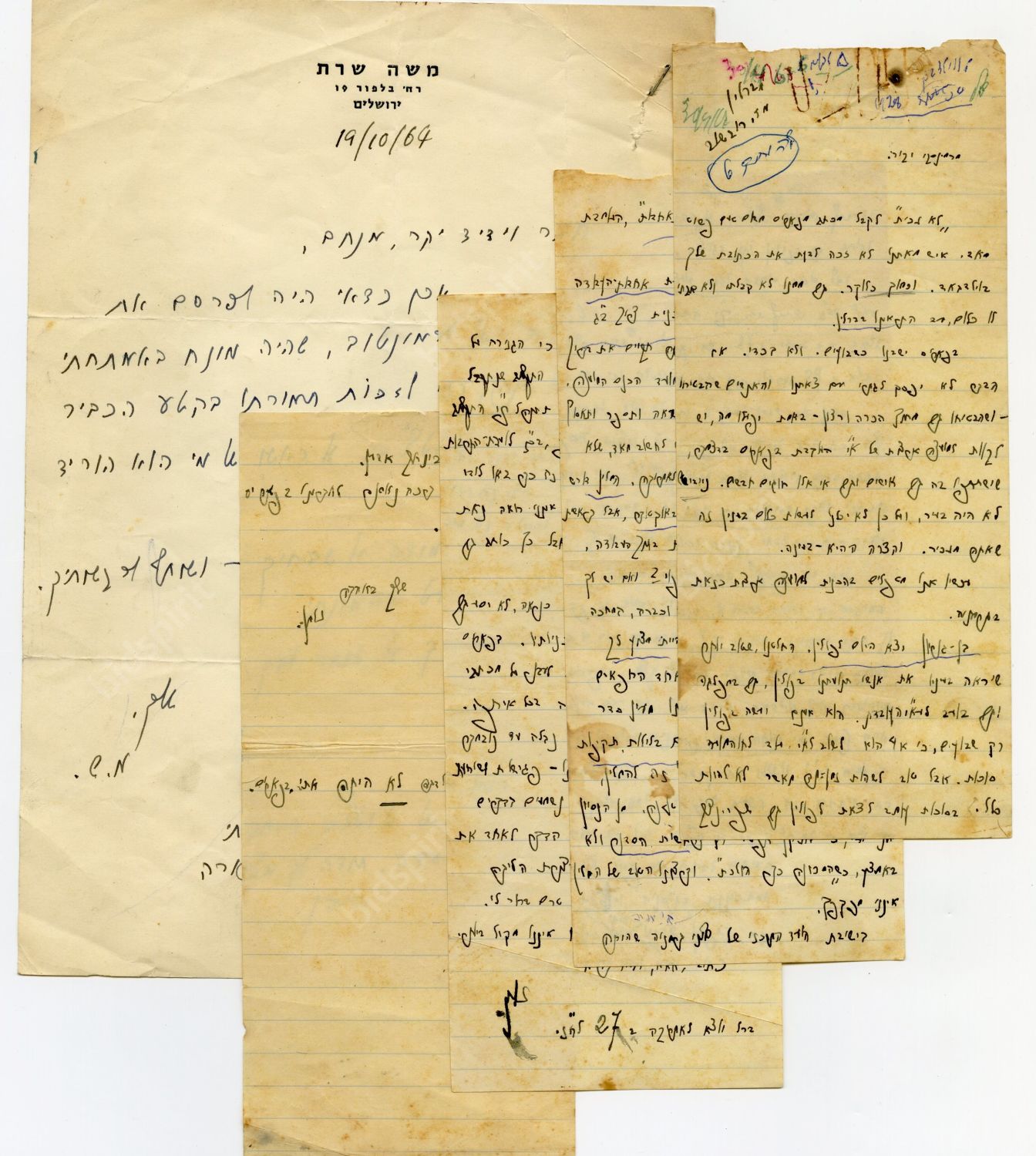
* A letter in the handwriting and signature of Zalman Shazar, the Third President of the State of Israel [c. 30s]. The letter is addressed to Mr. Minsky. In his letter, Shazar writes about Ben-Gurion's visit to Poland for a short time, and that " the troubles of Poland are known to us here ... Ben-Gurion will talk to Rice about his plans, and he adds : According to our work plan, we will spend until November in Western Europe. Most of our work - meetings and personal conversations. Outside the Zionist circles, things are heard more than inside. But if it comes to unite the personalities into some active circle, and even in the form of the league that is being planned in Germany and France Not yet clear to me ...". at the end of the letter he adds, 'Berl goes to America.' And other matters. [4] leaves. 21x10 cm Stains, fine condition. * Letter in the handwriting and signature of the second Prime Minister of the State of Israel, Moshe Sharett 19/10/1964 [about a year before his death]. In his letter, Sharett writes about "HaRiv," of Lermontov's which had been in with him for 45 years, and now it is worthwhile publishing it "in order to win his share in the great part of the Teutzev song." [1] Official stationery leaf. 25x18 cm. Folding marks, fine condition.
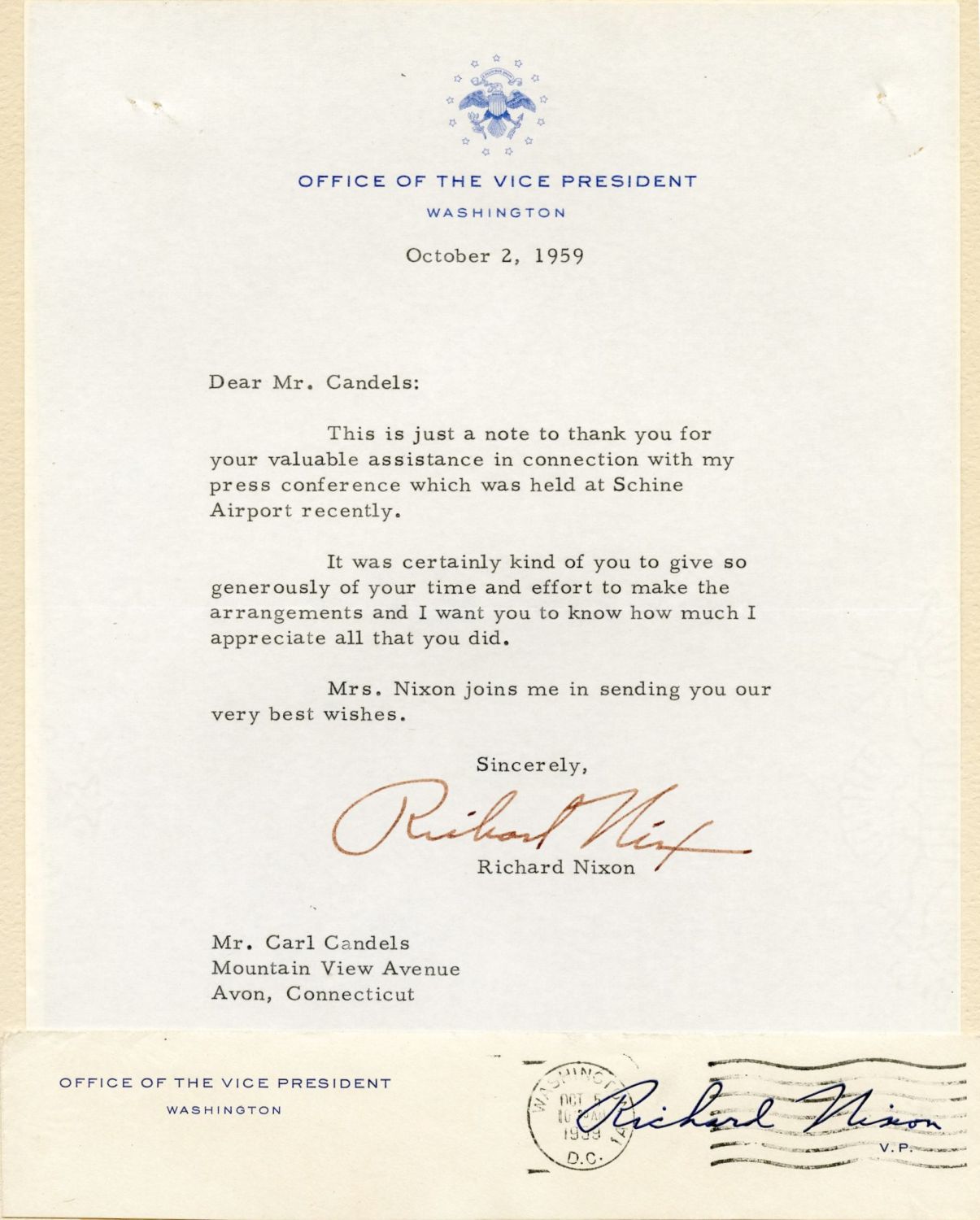
Letter signed by US President Richard Nixon October 2, 1959.
In his letter, Nixon thanks Mr. Cendels for the time, assistance and generosity he gave him behind the scenes at the press conference at Schine Airport. And also on behalf of his wife.
At public events, Nixon was a master in dealing with various audiences, even those who were hostile to him. About a year earlier Nixon and his wife went on a goodwill tour of South America. The journey was routine until Nixon and his escorts arrived in Lima, the capital of Peru, where he met with protesting students. Nixon went to the campus, got out of his car to confront the students, and stayed there until he had to return to the car after a barrage of objects thrown at him. In the hotel where he was staying, Nixon faced another mob, and one of the protesters even spit on him. In Caracas, the capital of Venezuela, Nixon and his wife were in turmoil with anti-American protesters and their limousine was attacked by an angry mob. According to biographer Ambrose, Nixon's brave demeanor "caused even his most bitter enemies to respect him."
Richard Milhauz Nixon [1913-1994] The 37th President of the United States, 1969-1974. Became the first and only American president to resign following Watergate. A number of historical achievements are registered in his name: Nixon was the president who ended the Vietnam War in 1973 and also the compulsory military service of the United States Army. His visit to the People's Republic of China in 1972 eventually led to the establishment of diplomatic relations between the two countries after decades of disconnection and hostility. In the Israeli context, he ordered the shipment of an airlift of military equipment and ammunition to assist Israel in the Yom Kippur War and removed Egypt from the Soviet sphere of influence.
[1] Official sheet of paper 23x18 cm. Attached is the original clipping envelope, in which the letter was sent with an additional signature of Nixon. The letter attached to a hard sheet for safekeeping.

Important letter signed by Albert Einstein to Dr. Siegfried Lehmann, founder of the Ben Shemen Youth Village, Princeton 27/1/1952. Aerogram, German.
After he was invited to participate in a public event at the Ben Shemen Youth Village, he informs Dr. Siegfried, the village manager, that he does not intend to attend. because of his rule over the years to refrain from accepting invitations to participate in events, even if very important, in order to preserve what Einstein calls "My well-defined privacy protection line". Einstein continues to apologize that this does not stem from selfishness, G-d forbid, or from controversy, and expects Dr. Siegfried to understand his refusal, which stems from a more comprehensive view of the world.On the margins of the letter Einstein adds words of congratulations and wishes for success in the continuation of his fruitful work. At the beginning of 1923, Einstein visited Palestine for the only time in his life, a visit intended to help Chaim Weizmann advance the establishment of the Hebrew University. In the only home available to the university on Mount Scopus, Einstein gave a lecture on relativity. Since he did not know English at the time, he pronounced it in French, after reading a few polite words in Hebrew that he had written in Latin letters. As a rule, Einstein refrained from attending public events unless they had long-term value for him. "There is no public event that gives me more pleasure than the initiative to establish a Hebrew University in Jerusalem, in the light of the Jewish tradition of learning and expansion that has been preserved for generations and under difficult conditions," he said. Since then he has not returned to the Land of Israel even though he was invited several times by various parties. Recipient of the letter Dr. Siegfried Lehmann [1892-1958] The founder of the Ben Shemen Youth Village was a close friend of Einstein long since he lived in Berlin.
In 1926 he founded the youth village. Einstein assisted him greatly in fundraising and managed an exchange of letters over the years. When Einstein noticed that the fact that he was invited to various events aimed at glorifying the event due to its publication without any significant long-term benefit he was prevented of participatedue to the fear of wasting his years in countless events. [1] Leaf, aerogram. Printed, German, on the margins of the letter is Einstein's hand signature. condition: very fine.

An important historical document - an appointment letter signed by King George II authorizing Harry Lane to the consul to "our province New York in America." St James' Courtyard, 22.5.1733.
'Trusly and welbeloved we greet you well. we being well satisfied of the loyalty, integrity and ability of our trusly and welbeloved .. herry lane to be one of our council of our province of new york in the room of robert walters... the twenty second of may 1733 in the fith year of our reigns…' George II [1683-1760] King of Great Britain and Ireland between 1727 and 1760, the second king of the House of Hanover. He also served as the elected prince of Hanover and Duke of the Duchy of Braunschweig-Lienburg in Germany.
In 1705 he received British citizenship, and in 1706 he was awarded the title "Knight of the Order of the Garter" by Queen Anne. This is the highest ranking English Order and its patron is the King himself. He was later crowned with many other British titles. When his father received the throne as King George I was crowned Duke of Cornwall, and Duke of Rothesay. In 1714 his father crowned him Prince of Wales, a title reserved for the heir to the British royal family. When he was crowned Prince of Wales, George was only thirty years old. George II received the throne with the death of his father in 1727. He is remembered in British history as the last British ruler who led his men to battle, in the Battle of Döttingen. The battle was fought against the French as part of a complicated European conflict called the "Austrian War of Succession." Although George's horse began to flee from the battlefield, he dismounted, and with a drawn sword led his men to victory in the battle, against excess French forces. His youngest son, Prince William Augustus, Duke of Cumberland, who also had military skills, was accompanied by his son. The most important event in the history books about the reign of George II was the Jacobite revolt in 1745, which almost led to his removal from the throne in favor of Crown Prince Charles Edward Stewart Crown Prince also known as the "beautiful Prince Charlie." This Jacobite revolt, supported by Scots from the mountainous region, culminated in the Battle of Claudine where the Hanover forces under the leadership of the son of George William Augustus (the Duke of Cumberland) destroyed the rebel forces and put an end to Stewart's demands for the English throne. This was the last battle in which British forces fought on the British island. King George II headed the American colonies through royal governors and their consuls. In 1732, he appointed William Cosby (1690-1736), the Royal Governor of New York, who recommended Lane's candidate to the position of Consul. Upon the arrival of the royal letter of appointment on 29.9.1733, Laine was appointed to the position.
The Commissioner for the position Harry Lane (died 1744) the son of the mayor of London, moved to New York in 1710, and served as Consul in 1733-1744. See also (Royal documents signed in similar contexts): Sotheby's Judaica catalog, June 4, 1996, New York, Item no. 92. Sotheby's Judaica catalog, November 30, 2005, New York, item 174. Sotheby's Judaica catalog, December 17, 2008 New York, item no.2.
[2] pages, 30 x 38 cm Three postage stamps with the British royal emblem in the body of the paper. remnants of wax seal, folding marks, few stains, fine condition.
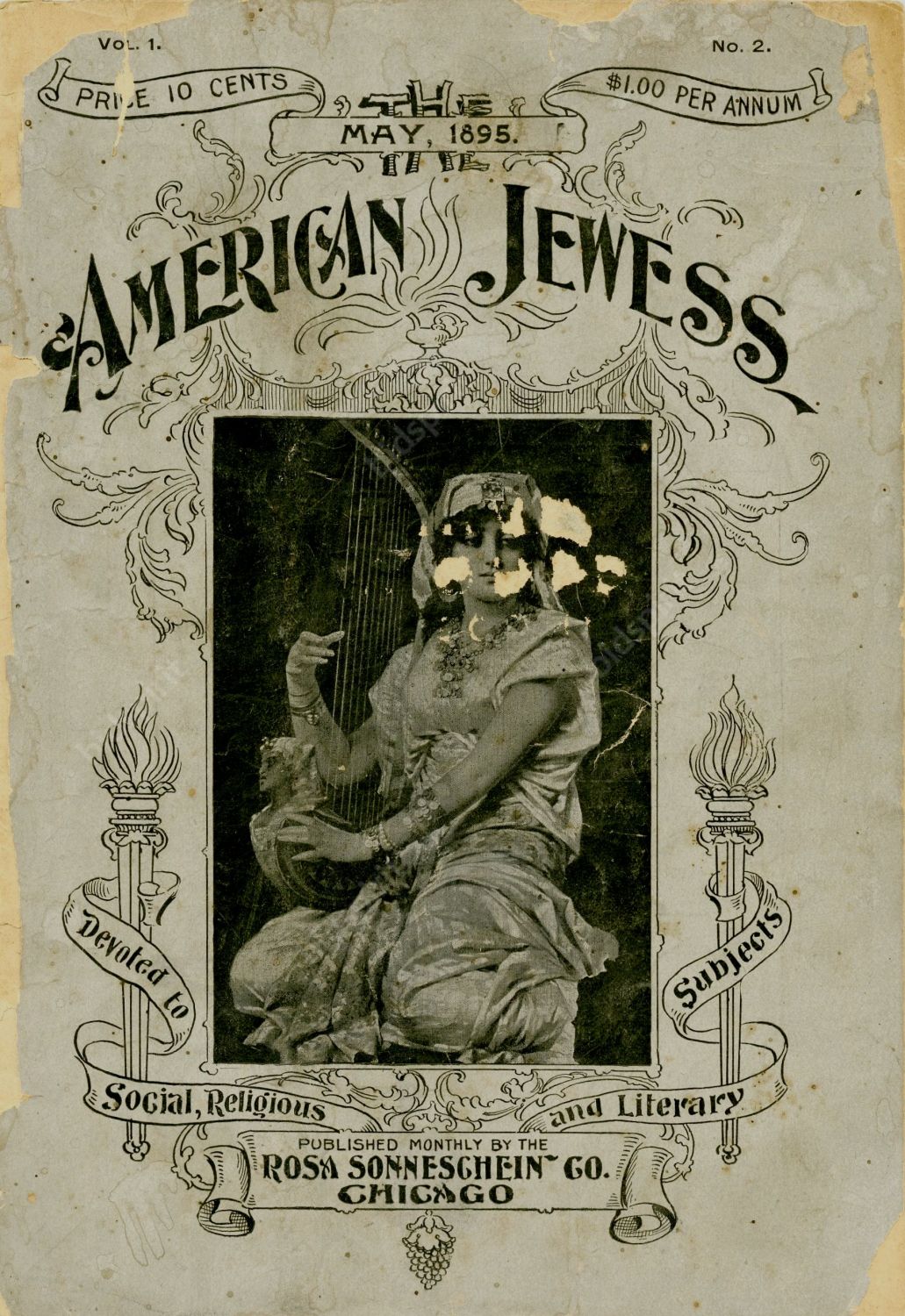
AMERICAN JEWESS Social religious and literary subjects was published once a month edited by Rosa Sonneschein co. Chicago, May 1895, No. 2. The Jewish-American magazine, published in Chicago and New York, defined itself as "the only magazine in the world devoted to the interests of Jewish women," the first ever English-language journal devoted to Jewish women to promote their status as women. The magazine, which was published between April 1895 and August 1899, in a total of 46 issues, culminating in a distribution of 31,000 copies, gave its first expression to Jewish women who did not see the religious, faith, and national aspects of their identity as clashes with each other. For the first time, he discussed issues that until then were taboo around the Jewish woman, such as membership in the women's synagogue, cycling for women in the streets of the city, the woman's role as active in American Zionism, equality of women's labor versus men, The women's section of the synagogue, and more.
In the first issue of "AMERICAN JEWESS," editor Rosa Sonstein wrote the revolutionary sentence that "not what happened, but what is Written makes history." Sonstein, the educated daughter of a Reform rabbi, gave a place in the editorials that regularly wrote about the aspirations, hopes, and fears of Jewish women at the end of the 19th century by expressing feminist views for the first time in a magazine. She expressed her views fearlessly on almost every possible topic related to advancing the status of the Jewish woman.
Before us the second issue that was published in May 1895. The design of its cover page is identical to that of the first issue. In addition to articles on SUCCESSFUL BUSINNESS WOMEN, or "WOMAN'S PART IN THE DARMA OF LIFE", the first time in American history appears an advertisement supposedly innocent of soap cleaning. But now the photographer is holding the soap in her hand, wearing a large prayer shawl.
See sothby's catalog Judaica, December 2014 Item No. 26.
Tears at borders of cover, detached cover. Missing back cover. Two leaves torn and missing. fine-moderate condition.
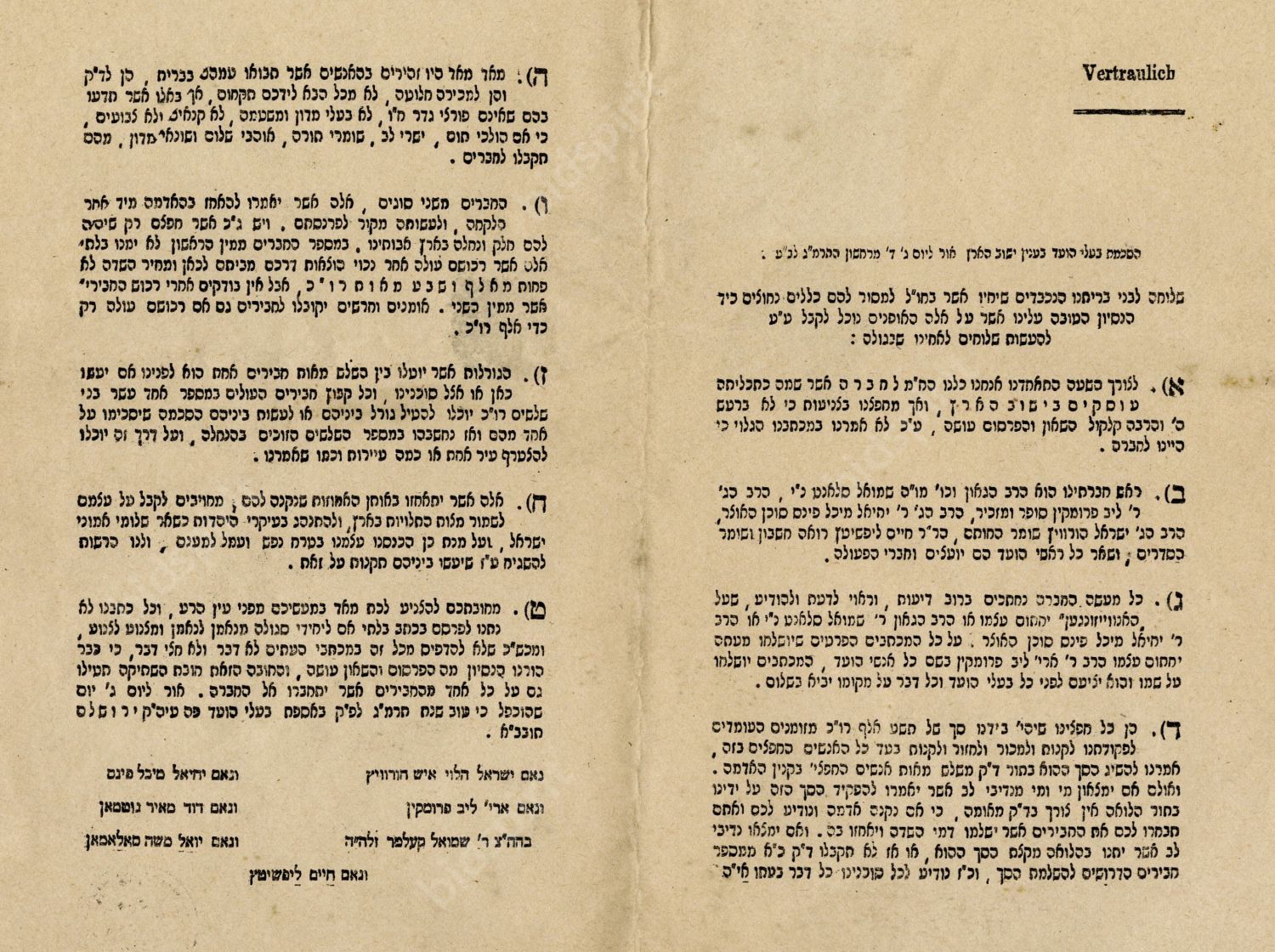
"The consent of the members of the committee regarding the settlement of the land on the third day of Marcheshon, 1883'. Early document - single leaf.
"For the purpose of the hour, we joined together, the undersigned, to the company whose purpose is to deal with the settlement of the country, But we want modesty... and a lot of disruption of the noise and advertising does therefore we did not say in our open letter that we were a company'. An important and unknown document with nine principles of the "Yishuv Eretz Israel" regarding the purchase of land for the expansion of the settlement of the Land of Israel. The document is signed by the great fathers of the The Jewish Yishuv in Palestine: Rabbi Yisrael Halevy Horowitz, Rabbi Aryeh Leib Frumkin, Yoel Moshe Solomon (both of the founders of Petah Tikva), Rabbi Yehiel Michal Pines, and David Meir Gutman.
The company that was founded for the purpose of expanding the Yishuv of Eretz Israel was headed by Rabbi Shmuel Salant (section 2) and the management positions were divided among its members. The purpose of the company was to buy land that is not inhabited as it appears in section 4: 'All our possessions we will have a total of nine thousand Ruble cash ... buy and sell and go back and buy for all the people who desire it ...' We must enter into negotiations only with those who observe the Torah: "And also that all the winners of the land that they buy through the company are obligated to take upon themselves the observance of mitzvot that depend on the land. And to act like the principles of Judaism like the rest of the faithful of Israel ... '.
[1] leaf. 27x22 cm. Very fine condition.
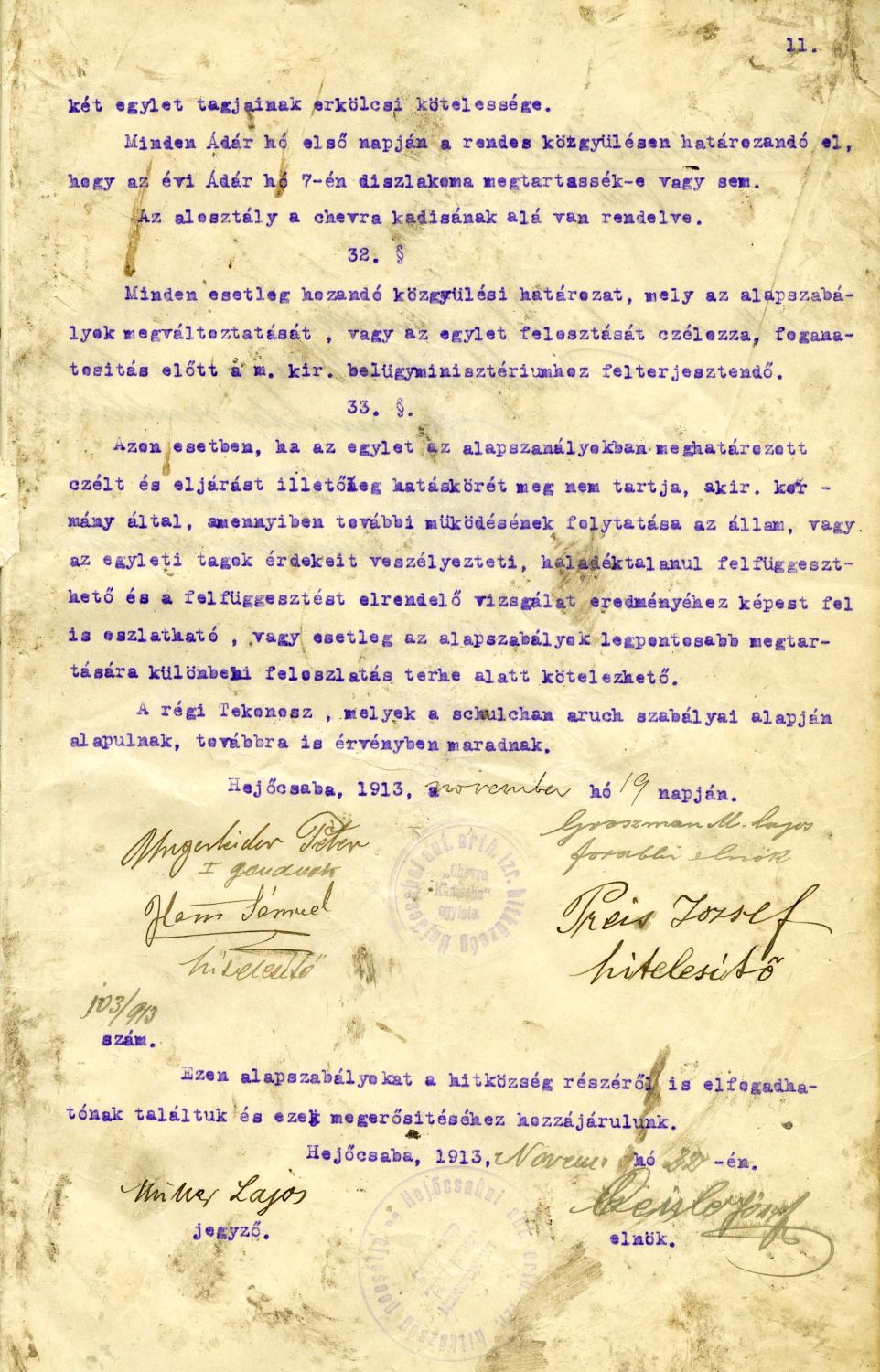
A lists booklet of the small Hungarian Jewish community in Hejocsaba - which was located in northeastern Hungary, 1913 . Stencil printing with signatures of community leaders. Hungarian. Already in the 17th century there was a Jewish settlement in Hejocsaba. During the 19th century the Jewish community expanded, and the Jews played a central role in the economic development of the city. In fact, the Jewish part of the city was administered entirely by the Hevra Kadisha. Following the riots, in the first decades of the 20th century there was a significant decline in the number of Jews in the city. Thus, for example, in 1840 there were 1280 Jews, whereas in 1930 the number dropped to only 272. During the Holocaust, the small part of the Jews who remained there was hidden by the local population, and the rest were taken by the Nazis to the concentration camp in Miskolc in northern Hungary. After the war, only 30 Jews returned to the city, and tried unsuccessfully to renew the Jewish settlement there.
The booklet was signed in 1913 by the local rabbis, and includes details about the division of roles in the Jewish community, various powers that are divided between the Jewish community and the local population, numerical data about the small community, and more.
Not thoroughly tested. Does not appear in the National Library. [11] leaves. fine condition.
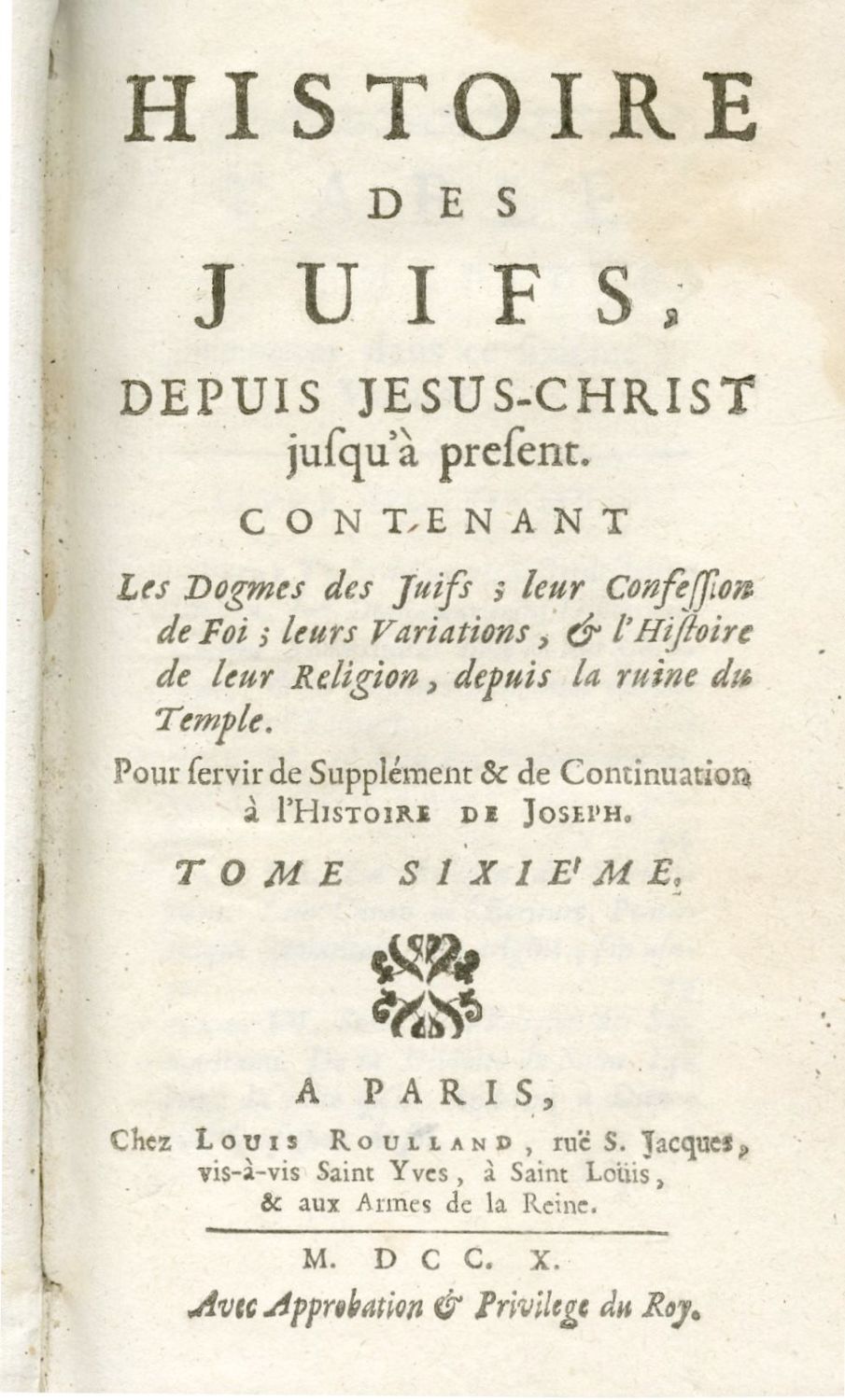
HISTOIRE DES JUIF depuis jesus-christ jusqu'à present - A study of Jewish history from the days of the Second Temple with an acceptance of what was not mentioned in the writings of Josephus Flavius, Paris 1705. The volume dealing with the wisdom of Kabbalah, with Kabbalistic illustrations. Part Six [out of six parts].
Research on the history of the Jewish religion, Jewish faith, and Jewish history. before us the volume dealing with The Basics of Kabbalah with folded pages with Kabbalistic illustrations and diagrams. On page 462 etching an imaginary figure of the typhoon.
96-642 p. 17 cm. Original leather binding with gilt lettering on spine, thick paper, Red leaf cutting, moth marks on spine, the body of the book in very fine condition.
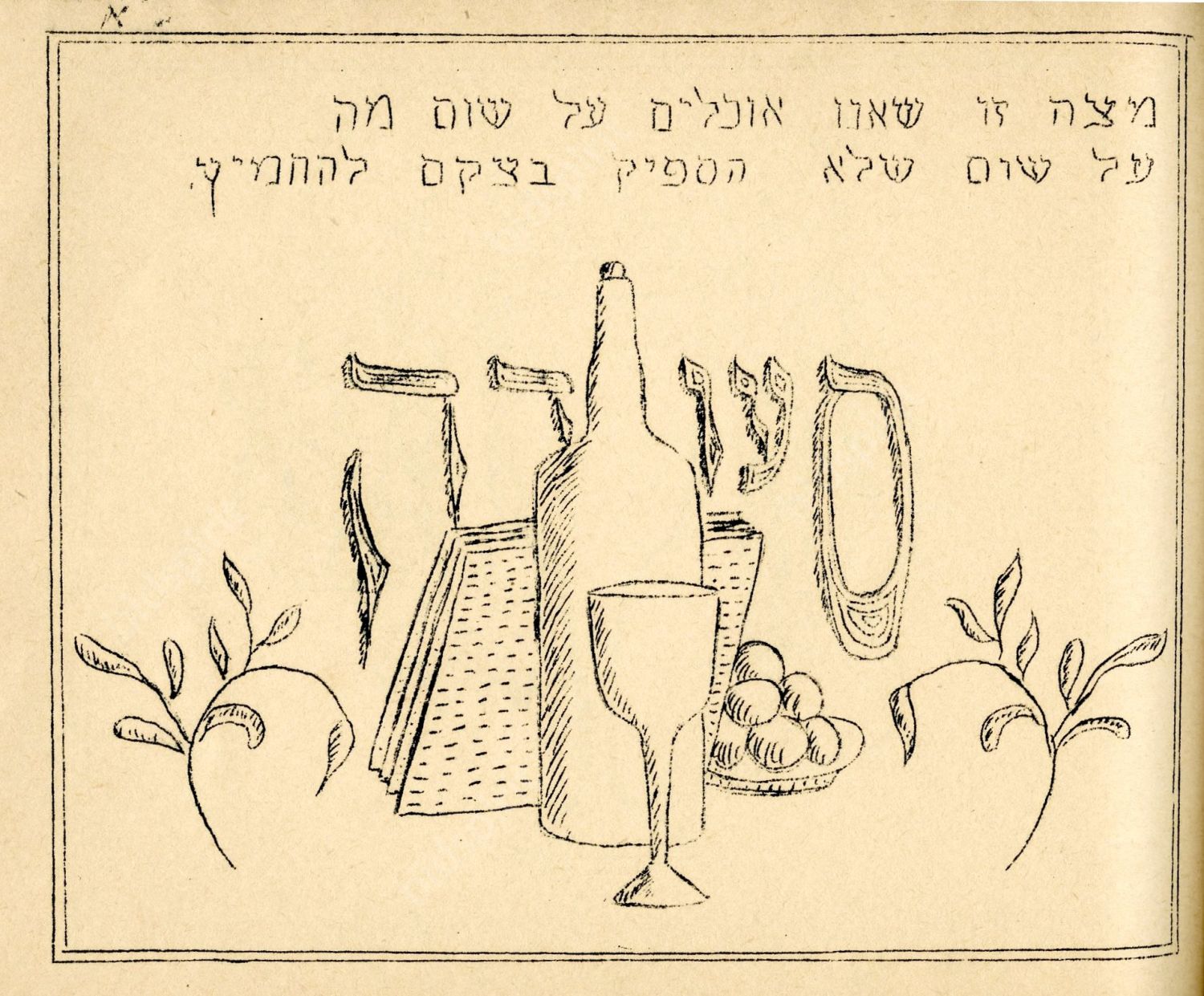
Non-traditional Haggadah, Kibbutz Degania Bet. Stencil printing if illustrations. Early kibbutz Haggadah.
According to Degania Archivist, Mr. Shlomo Cooper, referring to the Haggadah in the kibbutz archive, it is written in pencil on the details of 1930: "In the early 1930s, "The Passover seder, according to the testimony of the veterans of the place who remained with us, and it is possible that the member who wrote the date on the Haggadah '1930' meant that this was how they arranged the seder. But the Haggadah was printed later. In the early years, the seder was apparently arranged according to handwritten Haggadah'. According to testimony received from one of the veterans of Ein Harod, in 1930 the first Haggadah was also written there, but no of it copy was found. The Historian Muki Tzur reviewing the development of the kibbutz Haggadah in Degania B writes: "In any event, we will not be far from the truth if we assume that the first Haggadah in the movement is reflected in an unequivocal intention to place on the table a seder that speaks to the hearts of kibbutz members and suits their approach" [To a New Land You Pass the Kibbutz Haggadah and its History Edited by Zvi Shua,Shitim Publishing 2011 p. 95]. The Haggadah before us is identical in form and content to that spoken Haggadah, which is located in the archives of Degania B, which is written in pencil '1930'. The opening passage of the Haggadah is an original passage that appears only in this Haggadah and did not reappear in the kibbutz Haggadot that were printed over the following years: " On this night, the night of the holiday, the holiday of freedom and the spring, we all gathered together, our children and our friends - the whole family, the entire community, the whole group .' It is also added to the passage :'The whole night we children do not eat with you together, this night we all sit together ', The rest of the original passages have already appeared in the Haggadot that were printed afterwards: "Remember this day ... domem shita teyva ktana ... We will be blessed ... The vine ... and the redemption of our souls ... I am ready and willing to observe the mitzva of the first cup of four cups ... Halahma hania ... yete vyifsach ... Kumu Toui midbar ... am shomer...' and more. Another proof of the primacy of the Haggadah can be seen in a number of places of editing corrections that were handwritten in the corners of the Words or in the upper part, without the publisher's effort to insert them in the same square format of the original Haggadah letters. Thus, for example, on page 8: 'sheteamer yetziat mizrayim'', the word 'mizrayim' appears in small handwritten letters above the word 'yetziat'.
In addition the end of the passage that opens with the words 'am shomer thousands of years', a handwritten line was added (printed): 'האמנתי כי אדבר אני עניתי מאד וכ etc.'
In the later versions, the corrections are already part of the text body. The Haggadah contains quite a few passages from the traditional Haggadah because the first members of Degania during the Second Aliyah, at least in part, were still observant in one way or another. According to Tzur's article there, if it is indeed correct that the Haggadah Degania B is the first Haggadah in the Kibbutz Movement, this is the first Haggadah in which the verses of the Song of Songs were heard on Passover eve.
Degania B was founded in 1920, near Degania A in the Jordan Valley. It was established by immigrants from the Third Aliyah and several members of Degania A who eventually retired and joined the Nahalal track. A second group of young people from the Second Aliyah arrived in Kibbutz Degania Bet, including Levi Eshkol, who later became the Prime Minister of Israel, to which a group of immigrants from the Third Aliyah came from the city of Bobruisk. At the time of their arrival in the Jordan Valley, the third group of Degania III still lived there, but these were transferred to the Jezreel Valley and formed the Ginegar group. In the 1930s, groups of the Gordonia youth movement arrived in Degania. The census in 1931 counted 136 residents and counted 39 houses. On Steiner list The first Haggadah that appears on Kibbutz Degania B is dated to 1939. apparently did not see the Haggadah before us. In the National Library the first Haggadah from this kibbutz is from 1937. Before us is one of the early kibbutz Haggadot, probably printed in the mid-1930s. 39 leaves, printed on one side. A slight tear to the upper part of the spine. Very fine condition.
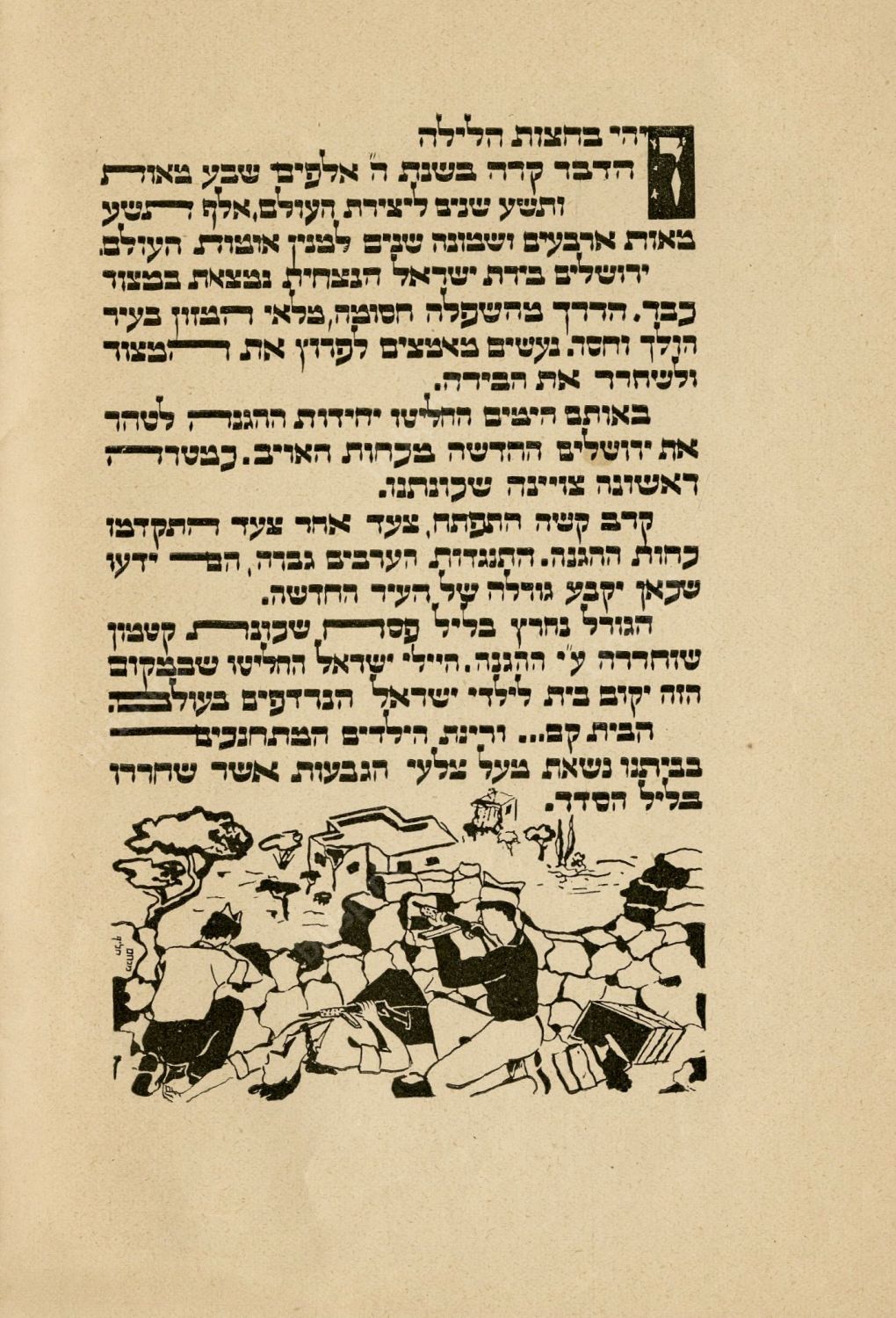
Non-traditional Haggadah Published by the Dr. Israel Goldstein Youth Farm. Jerusalem, 1952. Writing and Illustrations by Meir G. Many texts relating to the conquest of Jerusalem, the ingathering of the exiles, and the essence of the Passover holiday. The text of "Vayihi Be-hazi halayla", which refers to the redemption of Egypt, replaced with a text referring to the liberation of the Katamon neighborhood in Jerusalem on the eve of Passover: " And in the middle of the night Jerusalem was the eternal capital of Israel. The road from the lowlands is blocked, the food supply in the city goes on and on ... In those days, the Haganah units decided to purge the new Jerusalem from the enemy's ... A difficult battle developed ... Fate was sealed on Passover night The Katamon neighborhood was liberated by the Haganah. Israeli soldiers decided that this place would create a home for Israel's persecuted children in the world. The house is up ... and the children's raised in our house are carried over the hillsides that were released on Seder night. ' At the edge of the section, illustration of the soldiers of the Haganah are besieging the Katamon neighborhood by Menachem Kalif. (In the War of Independence, the neighborhood was a buffer between the Hebrew neighborhoods in the southern part of the city - Mekor Haim, Talpiot and Arnona - and Rehavia and the city center. After the Arab residents evacuated the neighborhood, it was relatively easily conquered by the Haganah in the first months of 1948). The Passover section of the Passover Haggadah is dedicated to the Passover holiday in Poland and Lithuania and the Passover holiday of Israel's exiles in the distant lands of the Diaspora, with the strange and strange customs, a vague inheritance of ancient generations: Pesach Yemen and Persia, Morocco and the Caucasus Mountains. This is one miraculous rhythm of the heartbeat of the mountain Jew in the Caucasus and the joyful dances of Hechalutz Hatzair, the world today from the new spot in the Jezreel Valley to celebrate its Passover in our eternal national capital ... " The text of Had Gadya is also different from the current version, and more.
Does not appear on the Steiner list. This year does not appear in the National Library. [16] leaves. Stains in binding. fine condition.
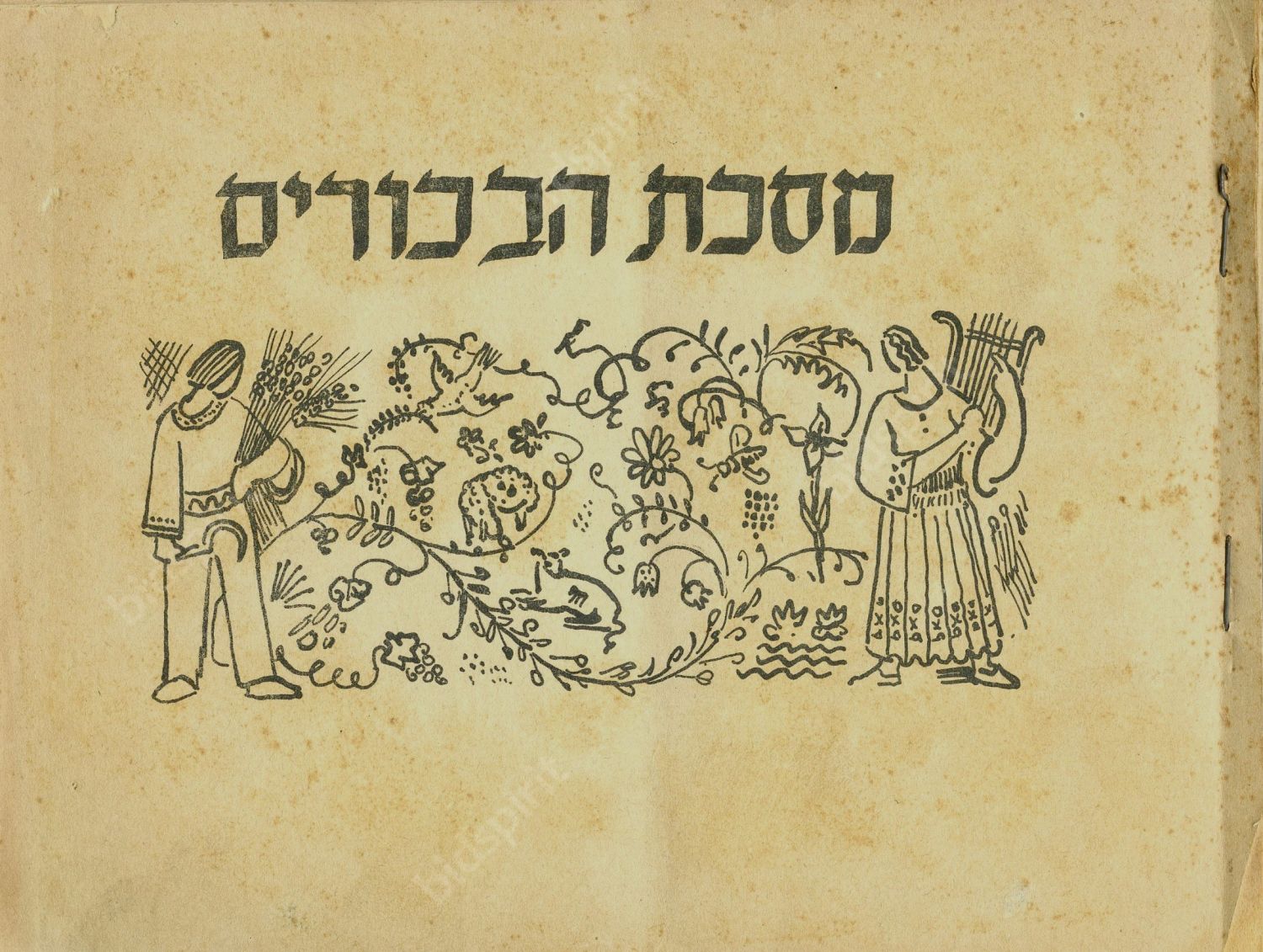
Maschet Bikurim, stencil printing with illustrations, special publication for Shavuot, published by the "Center for Culture". Formulas for submission the Bikurim from different kibbutzim. c- 1946-7.
At the beginning of the booklet is an introduction in which the writer defines the essence of the festival of the first fruits as a "folk agricultural holiday" that requires expression in song and dance, and also details the planning of the stage for the holiday. For this purpose, two drawings appear, one for the stage and the other for the dance floor and the application of the branches. Following are illustrations of the costumes for participants in the play, the holiday process including decoration and arrangement of the wagons, the procession accompanied by the orchestra, the division of roles on the stage: "folk dances that are already common in the country are of a rural nature." The author uses the wording of the tender Bikurim of Sha'ar Amakim 1946, together with the version of Beit Zera, [1945], and the contents of the proclamation bring the version of Mishmar Ha'emek 1946.
Rare and unknown publication. Does not appear in the National Library.
[1], 33 p. Few stains at title page. fine condition.
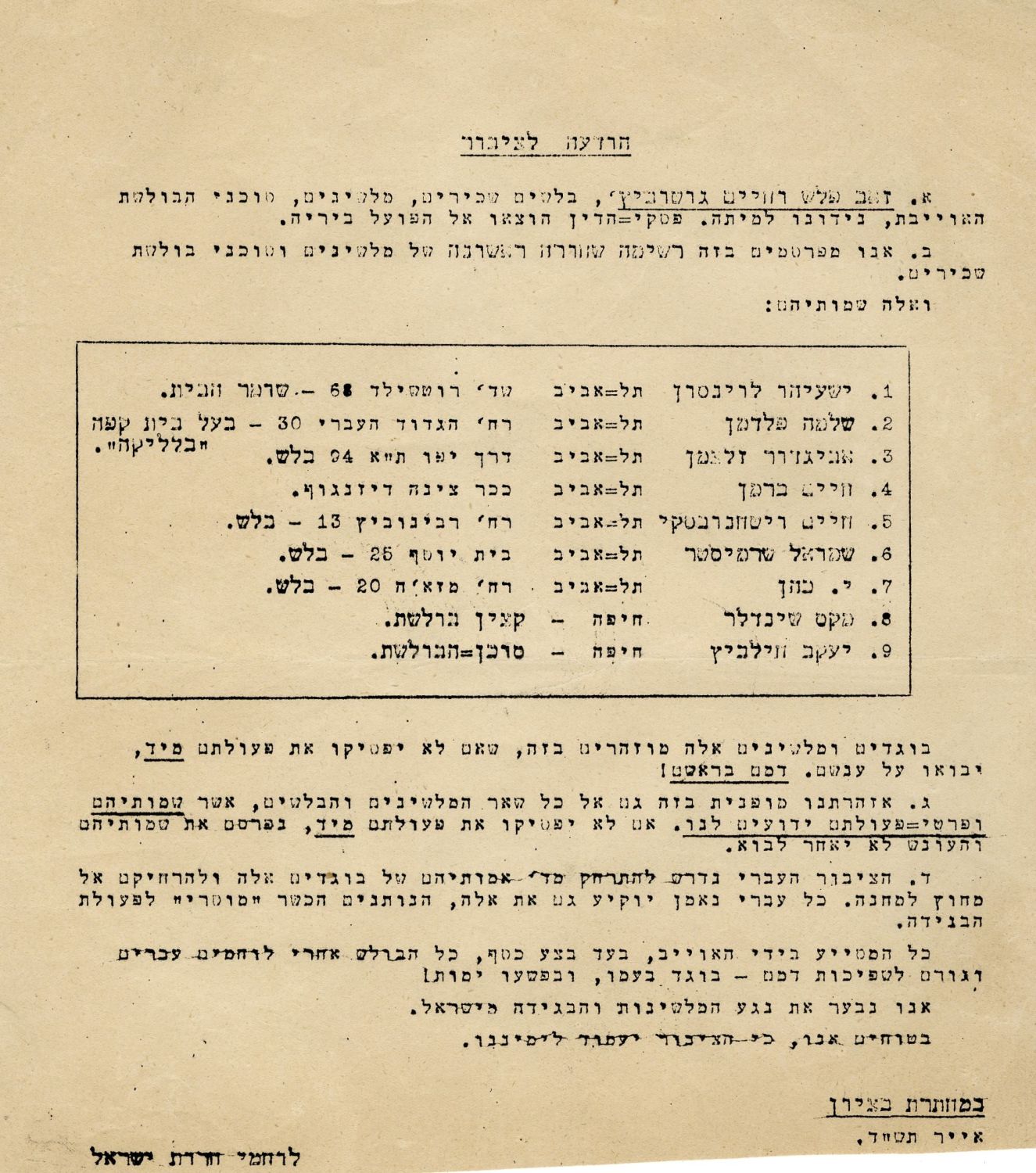
We publish in this a first black list of informers and agents of the employees ... traitors and informers are warned that if they do not stop their action immediately will be punished by blood in their heads'. List of wanted persons - Jews who served in the British Mandate police, Which led to the capture of Irgun fighters, as well as collaborators with the British police. 1944. Among the names on the list are Max Schindler and Ya'akov Chilevich. Schindler, a German-born Jew who served during the British Mandate as an officer in the Jewish section of the Mandatory Police and was responsible for monitoring Jewish underground organizations.
For him, the Lechi did not carry out the threat that appeared in the ad before us. It was the Irgun who decided to assassinate him for his activity against the underground organizations three years later in May 1947. In an attempt to assassinate a car in which he was traveling by explosive device, Schindler was seriously injured, in the hospital, the doctors saved his life. Then Schindler left the country. Ya'akov Chilevich [number 9 on the list] activists of the Irgun during the British Mandate, who betrayed his comrades and gave lists of Irgun members to the British police. When he was exposed, he was smuggled in by the British secret police to Cairo with the help of British forces. Nothing is known about its end. Shmuel Shermeister [Number 6 in the list] - was a Jewish policeman in the British army, his name became known around the Arloserov murder case, when he was one of the first to collect evidence. [1] leaf. 23x21 cm. Very fine condition.
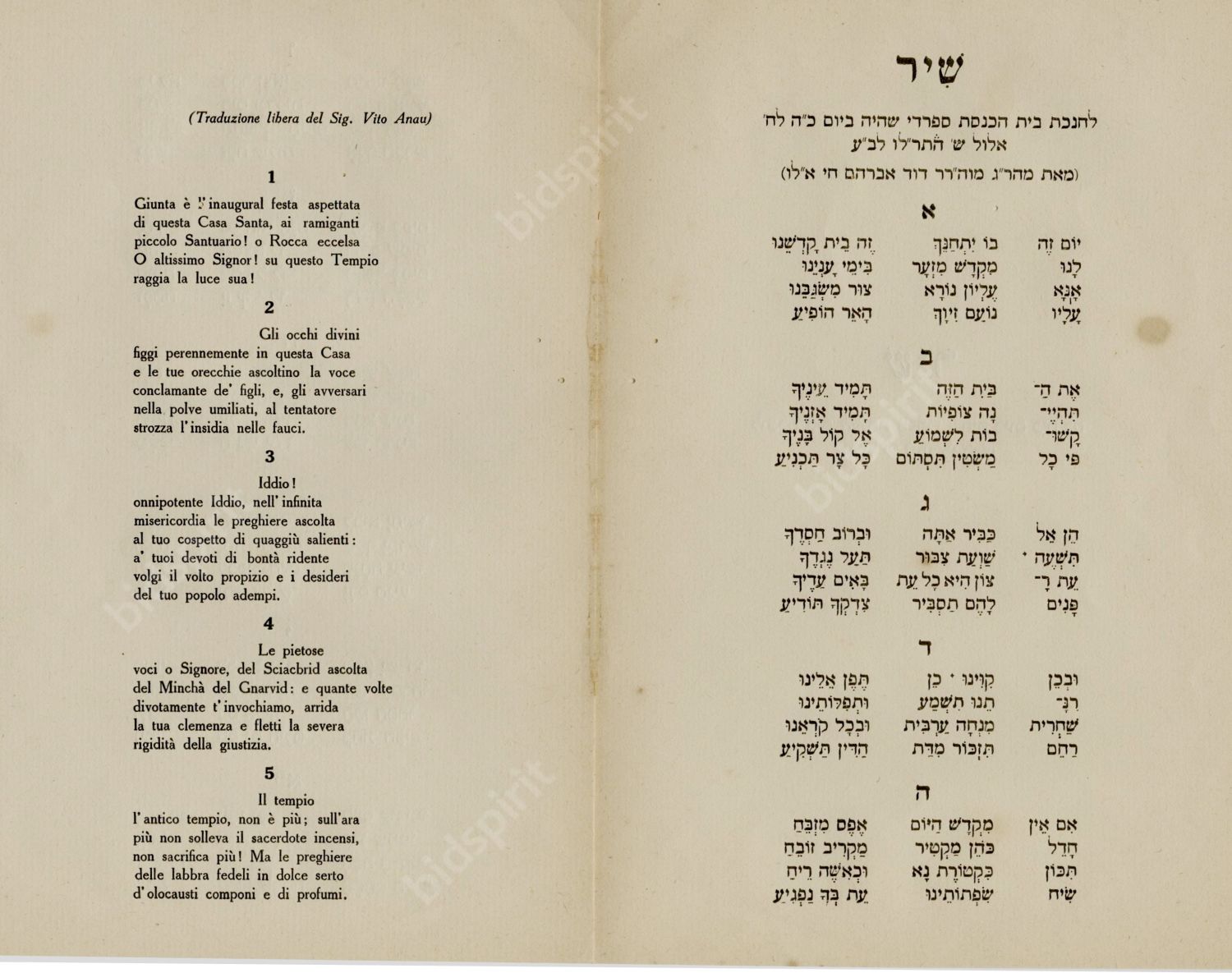
"This Day in which this Temple will be inaugurated" - a song dedicated to the inauguration of the Sephardic synagogue in Mantua on the 25th of Elul 1876, by Rabbi David Avraham Hai. Published by Arti Grafiche S. Belforte & C Livorno.
15 sing houses with an Italian translation page by page. In 1825 two jewish building was built in the center of the historic ghetto -The synagogue and the rabbi's house. In 1825 a three-story building was constructed, which served as an old age home. The synagogue, which was built on the second floor of the building, was inaugurated in 1876, although it was actually used for prayers towards the end of the 19th century. [8] p. 24 cm. thick paper, fine condition.
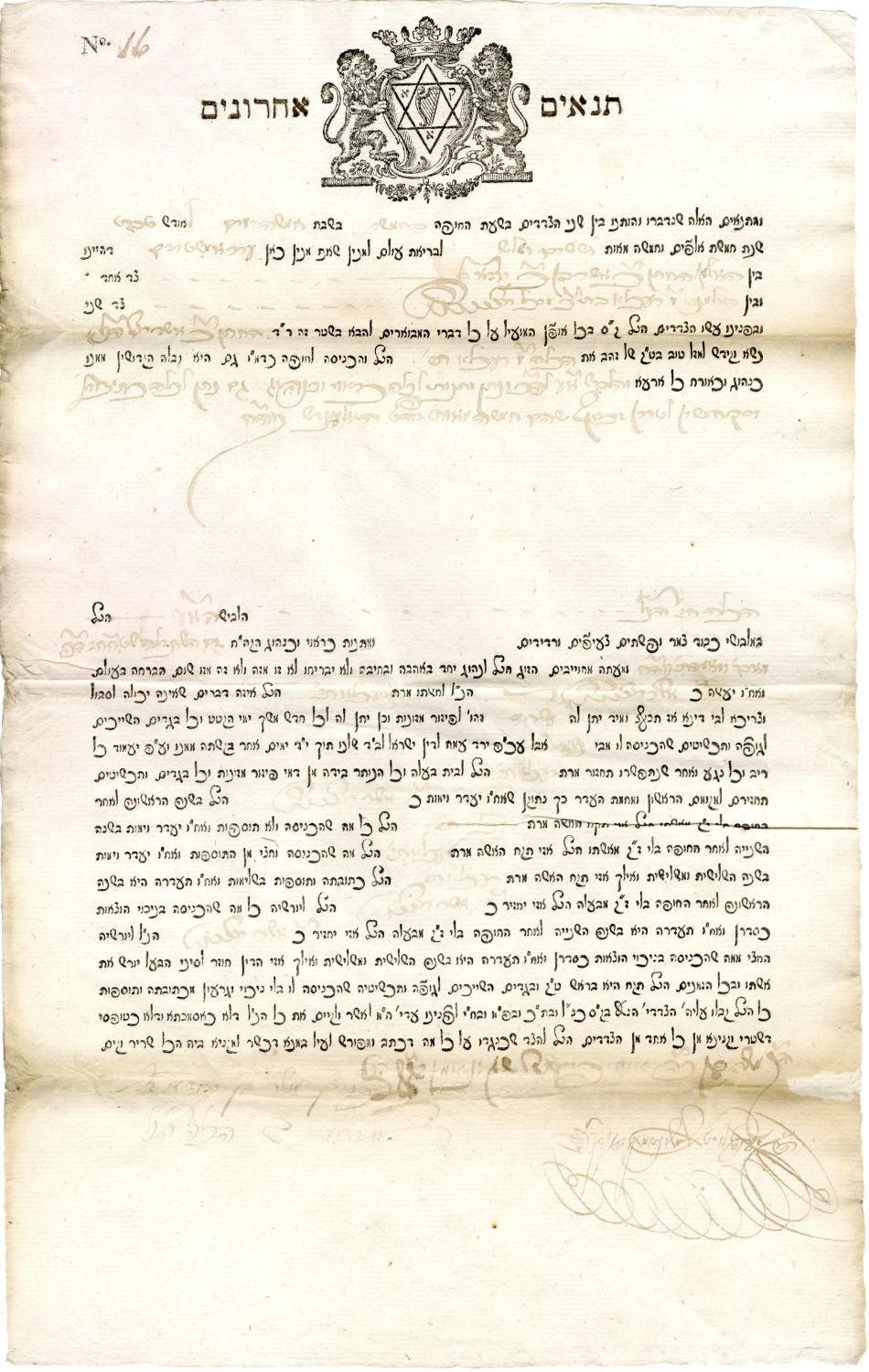
"Tena'im Acharonim" Document between the bridegroom Asher and widow Rochla, handwritten. Amsterdam, 1803. On the margins of the Tena'im, the signatures of the witnesses in Ashkenazi handwriting.
On top the emblem of the Ashkenazic community in Amsterdam A pair of lions holding a crown with a Star of David and a harp (the same symbol appears on the documents of ownership of a place in the Ashkenazi synagogue printed in this community during those years).
[1] thick sheet of paper. Folding marks. fine condition.
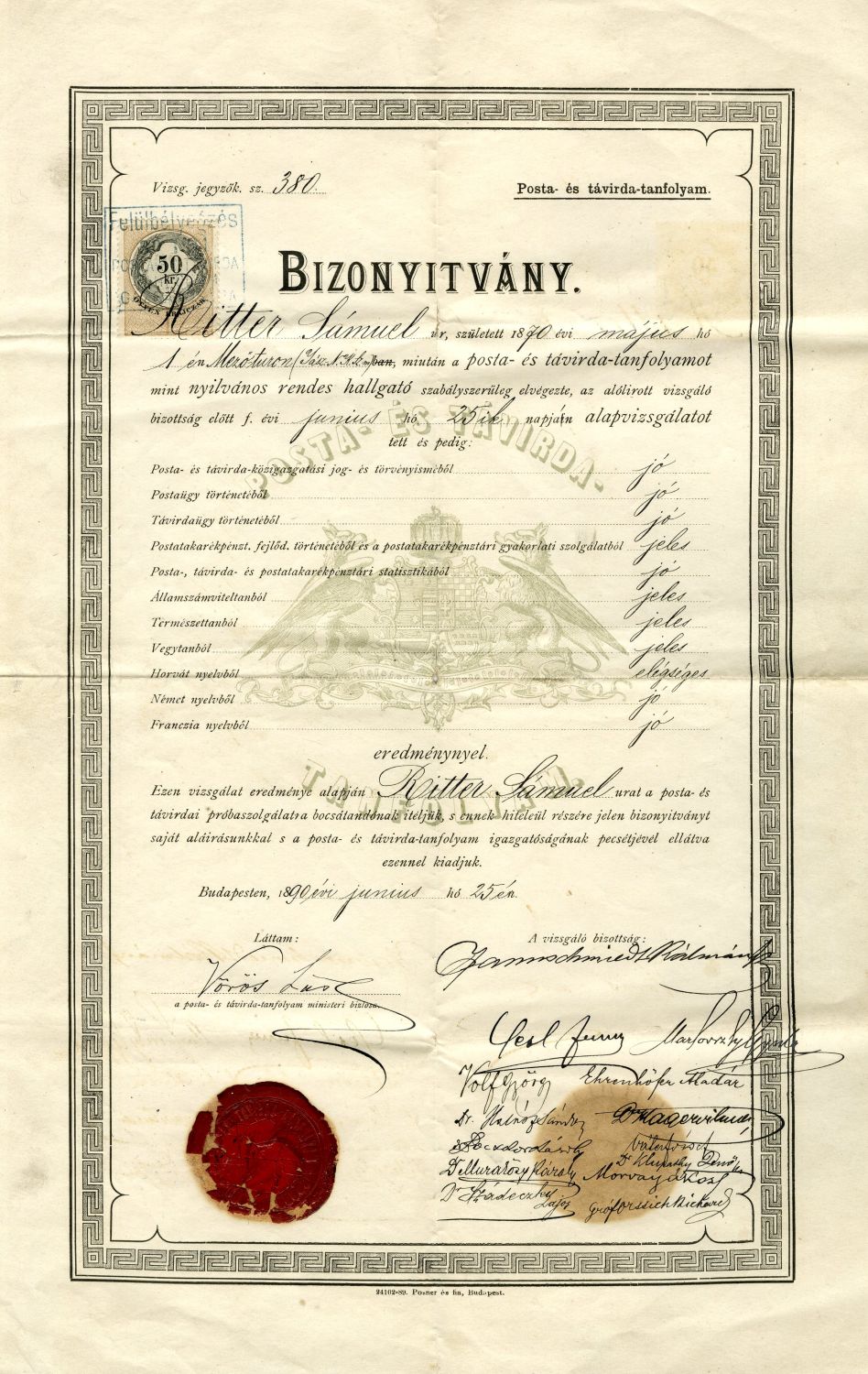
BIZONYITVANY - A Jewish student certificate by the name of Shmuel Ritter at the General vocational school in Budpast, signed on June 25, 1890 at the age of 20, signed by the principal and the teachers.
The general grades include general chemistry, Spoken Italian, and other languages.
42x27 cm.Thick paper. Folding marks. fine condition.
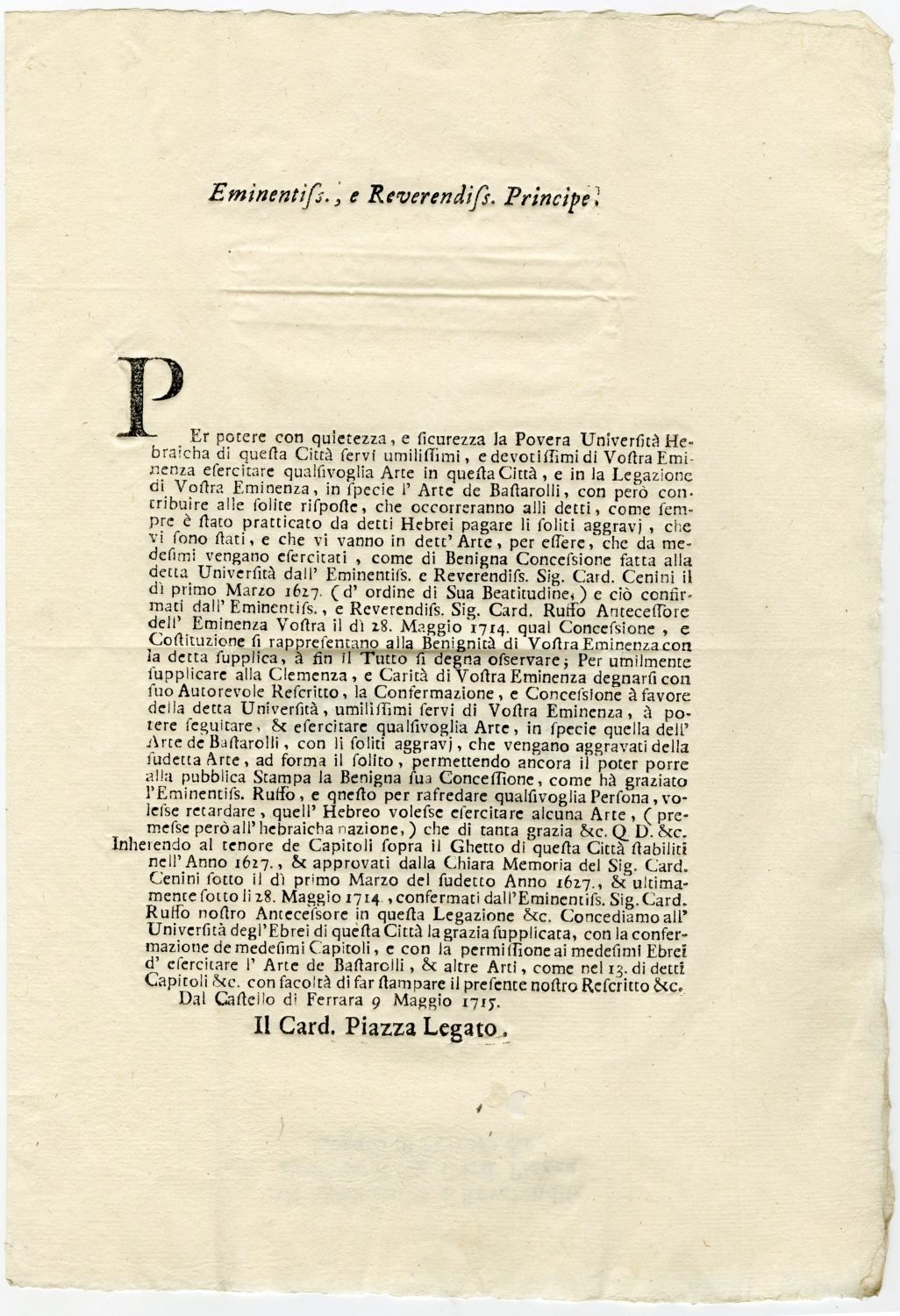
Eminentifs, e Reverendifs. Principe - A document in Italian containing a request to extend the permit to engage in professions permitted to Jews under the laws of the governor. Ferara 1715.
[2] leaves. Thick paper. Very fine condition.
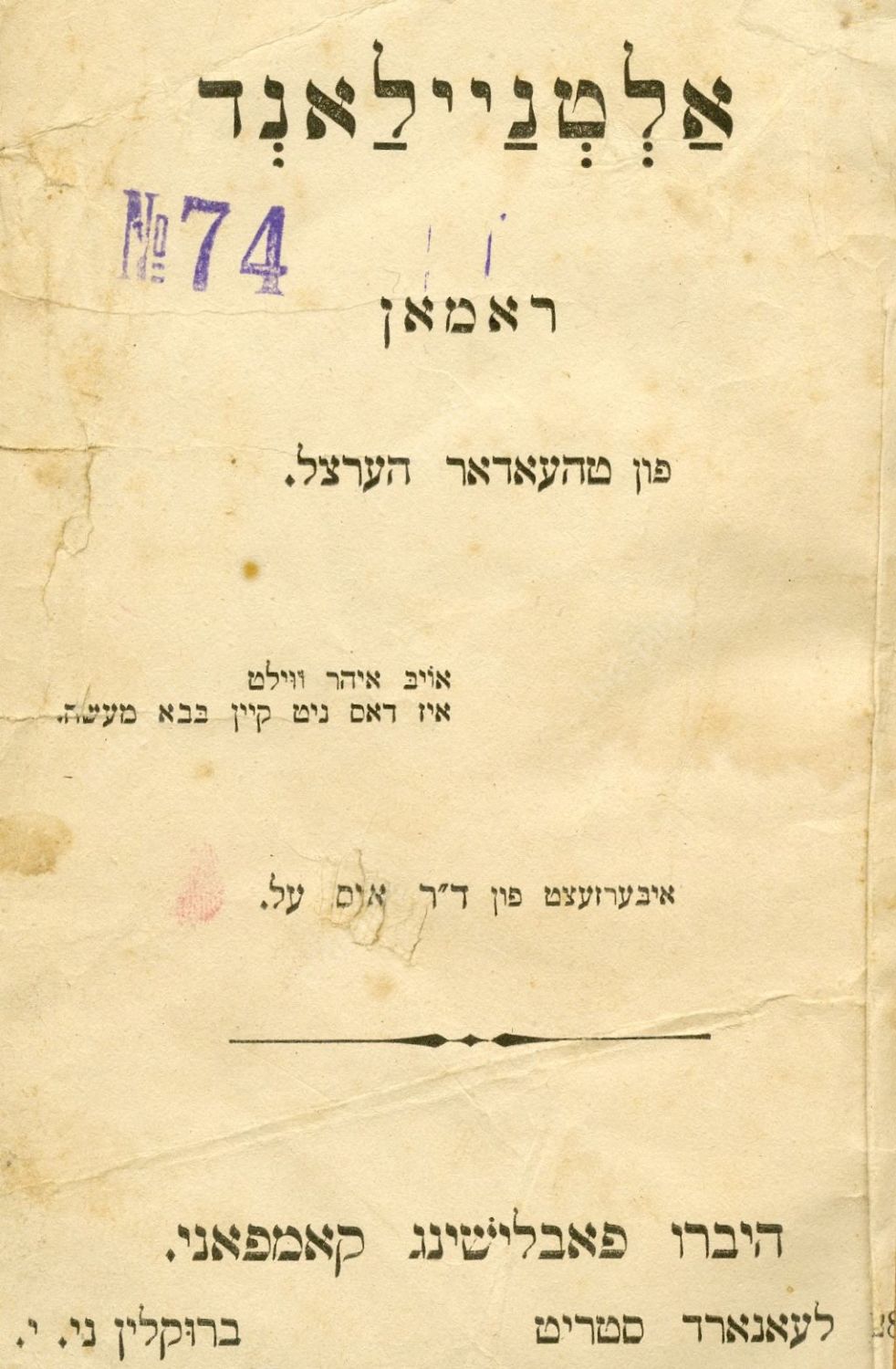
Altneiland, Roman von Tahadar Herzl [Altneuland, novel by Theodore Herzl]. translation by Isidor (Israel) Elyashiv, ["Baal Machshuvot"], published by the Hebrew Publishing Campany, Brooklyn. year is not mentioned, 1900s.
Early Yiddish translation of Theodor Herzl's utopian novel, "Altneuland" [First American edition?], published by the Hebrew Publishing Campani. The well-known edition of the Hebrew Publishing company is a short 286-page edition. This is a full and unknown edition of 488 pages parallel to the number pages of the Yiddish translation that published in Warsaw in 1902. It is possible that before us the first American Yiddish edition of the book. we can find various handwritten instructions for erasing entire sections of the book, apparently for the shortened known edition. Through the Altneuland plot, Herzl describes his vision of the future Jewish state in the Land of Israel. The book was published several years after the publication of Herzl's book "The Jewish State" and after his visit to Eretz Israel. In the same year in which it was published, Altneuland was translated into Yiddish and Hebrew. At Herzl's personal request, the translation of the book into Yiddish was made by the publicist, editor and literary critic Isidor elyashiv.
Rare edition, possibly a single copy in the world. Unknown in the bibliography, not registered on OCLC. This edition does not appear in the National Library.
488 pages. Cover partly detached. Minor tears to title page. fine condition.

* Davar newspaper dated August 18, 1949. Its title : 'The bones of the forerunner were buried in the bosom of the homeland in a holy and revered splendor of the tens of thousands of the House of Israel .' On the same date, the newspaper also announces the conversion of the name of the mountain where Herzl was buried to 'Mount Herz'l: "On the map of Israel a new name was added yesterday, among the mountains around Jerusalem, a mountain bearing the name Herzl, the forerunner of the new Jewish state." . As well as articles about the 'Journey of the Ark' accompanied by a convoy of 75 cars and a photograph of the coffin in the courtyard of the national institutions.
* The newspaper Davar of August 17, 1949. Its title: ' The viewer of the State of Israel is gathered today to his land - his people ' and 'The funeral of the bones of Herzl - not a procession but victory journey' - the masses of Israel and their elected members of the Knesset pay tribute to the father of Zionism. Herzl's bones were transferred from Lod to the plaza in front of the Knesset building. Today the funeral goes to Jerusalem.' * The "Dor" newspaper of July 17, 1949: 'Herzl Day - Israel's Army Day'.
general condition: Very fine.
Created and Develop with 🤍By webe ©2024